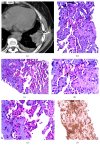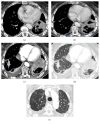New Insights about Pulmonary Epithelioid Hemangioendothelioma: Review of the Literature and Two Case Reports
- PMID: 28884037
- PMCID: PMC5573100
- DOI: 10.1155/2017/5972940
New Insights about Pulmonary Epithelioid Hemangioendothelioma: Review of the Literature and Two Case Reports
Abstract
Pulmonary epithelioid hemangioendothelioma (PEH) is a rare neoplasm of vascular origin. There are three different major imaging patterns identified in thoracic manifestation of epithelioid hemangioendothelioma: (1) multiple pulmonary nodules; (2) multiple pulmonary reticulonodular opacities; and (3) diffuse infiltrative pleural thickening. Radiographically, presence of bilateral multiple nodules is the most common pattern of presentation. The diagnosis is made on the basis of histopathological findings and confirmed by positive immunohistochemistry staining. Although the prognostic factors for PEH have not yet been well established, a better prognosis is usually associated with the multinodular pattern. We report two different imagological presentations of this rare disease, based on two institutional experiences, along with a review of the relevant literature.
Figures













Similar articles
-
Epithelioid haemangioendothelioma-a rare cause of right pleural effusion and multiple primary nodules: Case report & review of the literature.JRSM Open. 2023 Aug 7;14(8):20542704231188569. doi: 10.1177/20542704231188569. eCollection 2023 Aug. JRSM Open. 2023. PMID: 37560747 Free PMC article.
-
Pleural Epithelioid Hemangioendothelioma: A Case Report and Literature Review.J Natl Med Assoc. 2016 May;108(2):124-9. doi: 10.1016/j.jnma.2016.05.001. J Natl Med Assoc. 2016. PMID: 27372473 Review.
-
Thoracic epithelioid hemangioendothelioma: imaging and pathologic features.Acta Radiol. 2011 Mar 1;52(2):161-6. doi: 10.1258/ar.2010.100292. Acta Radiol. 2011. PMID: 21498344 Review.
-
Primary pulmonary epithelioid hemangioendothelioma.BMJ Case Rep. 2023 Sep 14;16(9):e254915. doi: 10.1136/bcr-2023-254915. BMJ Case Rep. 2023. PMID: 37709495
-
Metastatic Pulmonary Epithelioid Hemangioendothelioma: A case report and review of the literature.Respir Med Case Rep. 2012 Nov 26;7:17-20. doi: 10.1016/j.rmcr.2012.09.003. eCollection 2012. Respir Med Case Rep. 2012. PMID: 26029602 Free PMC article.
Cited by
-
Epithelioid hemangioendothelioma: evaluation by 18F-FDG PET/CT.Am J Nucl Med Mol Imaging. 2021 Apr 15;11(2):77-86. eCollection 2021. Am J Nucl Med Mol Imaging. 2021. PMID: 34079637 Free PMC article.
-
Cryoablation for airway stenosis caused by malignant pulmonary epithelioid hemangioendothelioma: a case report.AME Case Rep. 2024 Nov 27;9:28. doi: 10.21037/acr-24-106. eCollection 2025. AME Case Rep. 2024. PMID: 39866250 Free PMC article.
-
Multiple bilateral pulmonary epithelioid hemangioendothelioma mimicking metastatic lung cancer: case report and literature review.J Int Med Res. 2020 Apr;48(4):300060520913148. doi: 10.1177/0300060520913148. J Int Med Res. 2020. PMID: 32314617 Free PMC article. Review.
-
Pleural Epithelioid Hemangioendothelioma (EHE): A Case Report.Cureus. 2023 Jul 3;15(7):e41308. doi: 10.7759/cureus.41308. eCollection 2023 Jul. Cureus. 2023. PMID: 37539424 Free PMC article.
-
CT-guided Biopsy for the Diagnosis of Pulmonary Epithelioid Hemangioendothelioma Mimicking Metastatic Lung Cancer.Intern Med. 2018 Dec 15;57(24):3631-3635. doi: 10.2169/internalmedicine.1063-18. Epub 2018 Aug 10. Intern Med. 2018. PMID: 30101918 Free PMC article.
References
-
- Weiss S. W., Ishak K. G., Dail D. H., Sweet D. E., Enzinger F. M. Epithelioid hemangioendothelioma and related lesions. Semin Diagn Pathol. 1986;3(4):259–287. http://www.ncbi.nlm.nih.gov/pubmed/3303234. - PubMed
-
- Dail D. H., Liebow A. A., Gmelich J. T., et al. Intravascular, bronchiolar, and alveolar tumor of the lung (IVBAT): An analysis of twenty cases of a peculiar sclerosing endothelial tumor. Cancer. 1983;51(3):452–464. doi: 10.1002/1097-0142(19830201)51:3<452::AID-CNCR2820510317>3.0.CO;2-M. doi: 10.1002/1097-0142(19830201)51:3<452::AID-CNCR2820510317>3.0.CO;2-M. - DOI - DOI - PubMed
-
- de Albuquerque A. K. A. C., Romano S. d. O., Eisenberg A. L. A. Epithelioid hemangioendothelioma: 15 years at the National Cancer Institute. Literature review. Brazilian Journal of Pathology and Laboratory Medicine. 2013;49(2):119–125. http://www.scielo.br/scielo.php?script=sci_arttext&pid=S1676-2444201....
-
- Fletcher C. D. M., Bridge J. A., Hogendoorn PCW M. F. WHO Classification of Tumours of Soft Tissue and Bone. 4th. Vol. 5. WHO/IARC Classification of Tumours; 2013. http://publications.iarc.fr/Book-And-Report-Series/Who-Iarc-Classificati....
Publication types
LinkOut - more resources
Full Text Sources
Other Literature Sources

